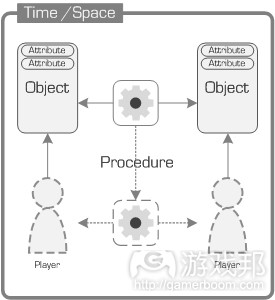以游戏原子模式分析游戏机制基本结构
作者:Hatamoto mizu
游戏机制的定义是什么?答案五花八门。作为一名游戏设计者和老师,我也总是被这些模糊的术语弄得困惑不已。如果你有兴趣不妨去查阅维基百科等资料对“游戏机制”的定义。
本文的主旨并非阐述游戏定义,而是探索游戏机制的基本结构。我将这个结构称为“游戏原子”,游戏原子代表所有游戏机制中最基础的模块。
游戏原子共有5大要素,即对象、属性、过程、玩家、时间和空间。“对象”通常包括玩家虚拟形象、敌人、随身物品、boss、军队、武器、弹药、能量和可拾取的物品等。所有的对象都有一系列“属性”,这些属性会决定或影响玩家的速度、健康值、损害值、生命值、弹药等与对象相关的内容。对象及其属性是因“过程”而产生交集,“过程”与选择、移动、开火、射击、攻击、敲打、踢、损害、拾取弹药、游戏结束等游戏动作或事件相关。“过程”也可用于设计玩家之间的社交互动,这实际上就是一种仅有玩家可支配的次级过程。社交过程的例子包括多人模式、协作、投票、竞标等等。“玩家”就是指操作游戏的人,或者一些发挥启发作用的AI,他们会决定游戏“过程”、“对象”及其元素的控制情况。最后,这些元素都发生在一定“时间”中(游戏邦注:例如回合制、限时任务、节奏、开火速度、延迟攻击等),并受到“空间”的限制(例如地点、世界、地图产、区域、关卡、屏幕等)。
上述所有元素就是我所谓的“游戏原子”,在能够描述游戏机制的基本元素之前,我一直使用这种模式创建自己的游戏流程图和设计文件。游戏原子是我理解游戏设计的第一步,除此之外,玩法机制和游戏体验也是我关注的其他层面。
游戏原子模式是一个有助于拟定游戏机制的实用工具,游戏机制本身就具有多样性,甚至还有大量看起来完全是另一种机制的小变体。我们必须认识到游戏机制实际上是一个描述重复内容的主观看法。(本文为游戏邦/gamerboom.com编译,拒绝任何不保留版权的转载,如需转载请联系:游戏邦)
The Game Atom: The fabric of game mechanics
What is a game mechanic? There are several definitions. All of them different. As a game designer and teacher I have been frustrated with the vagueness of the term. If you are interested in the current discourse about game mechanics you may wish to check these out:
Wikipedia: Game Mechanics
Defining Game Mechanics
Game Development Essentials: Gameplay Mechanics
Introduction to Game Development, 2nd Edition
The purpose of this post is not to identify or define game mechanics but rather explore the most basic structure of the game mechanic. I term this structure as the game atom. The game atom represents an essential pattern within all game mechanics.
The game atom exits out of five main elements. These being objects, attributes, procedures, players, time and space. Objects are often represented in games by avatars, enemies, traps, bosses, units, weapons, ammo, power-ups, pick-ups, etc. All objects have a number of attributes, which determine or influence the speed, health, damage, life, ammo, etc. of the object to which they are attached. Objects and their attributes interact through procedures, which can be related to actions or events in a game such as select, move into, trigger, shoot, hit, punch, kick, take damage, pick-up ammo, game over, etc. Procedures can also be designed to stimulate social interaction between players, which is essentially a second order procedure that only the players can resolve. Examples of social procedures would be multi-player, cooperation, voting, biding, etc. Players represent either people or some sort of heuristic or procedural A.I. (artificial intelligence), which then determine the control of related game procedures, objects and their elements. Finally, these elements exist with the constants of time (turns, timed limits, rhythm, rate of fire, delay after attack, etc.) and the limits of the space (location, worlds, maps, boards, fields, levels, screens, etc.) that they occupy.
Together all these elements represent what I have termed the game atom. Beyond attempting to describe the most basic elements of a game mechanic, this model forms the framework for my flowcharting and design document methods. The game atom is also the first layer in my model of understanding game design, which I call the aims of game design. Besides game mechanics, the ‘aims’ also include the play mechanics and game-play experience layers.
The game atom is a practical tool and it can help map out game mechanics. Game mechanics themselves have a tremendous variety and even small variations in seemingly like mechanics can be seen as entirely different mechanic. We must realize that the game mechanic is actually a subjective attempt at describing some of the recurring patterns that can be found in game design. If you are interested in a catalog of these patterns I suggest reading Patterns in Game Design (Game Development Series)by Bjork and Holopainen. (source:gamedesigntools)








































 闽公网安备35020302001549号
闽公网安备35020302001549号